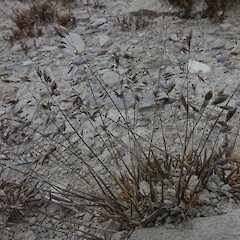Poa lindsayi
Common name
Lindsay’s poa
Family
Poaceae
Flora category
Vascular – Native
Endemic taxon
Yes
Endemic genus
No
Endemic family
No
Structural class
Grasses
NVS code
The National Vegetation Survey (NVS) Databank is a physical archive and electronic databank containing records of over 94,000 vegetation survey plots - including data from over 19,000 permanent plots. NVS maintains a standard set of species code abbreviations that correspond to standard scientific plant names from the Ngä Tipu o Aotearoa - New Zealand Plants database.
POALIN
Chromosome number
2n = 28
Current conservation status
The conservation status of all known New Zealand vascular plant taxa at the rank of species and below were reassessed in 2017 using the New Zealand Threat Classification System (NZTCS) – more information about this can be found on the NZTCS website. This report includes a statistical summary and brief notes on changes since 2012 and replaces all previous NZTCS lists for vascular plants.
Please note, threat classifications are often suggested by authors when publications fall between NZTCS assessment periods – an interim threat classification status has not been assessed by the NZTCS panel.
- Conservation status of New Zealand indigenous vascular plants, 2017 . 2018. Peter J. de Lange, Jeremy R. Rolfe, John W. Barkla, Shannel P. Courtney, Paul D. Champion, Leon R. Perrie, Sarah M. Beadel, Kerry A. Ford, Ilse Breitwieser, Ines Schönberger, Rowan Hindmarsh-Walls, Peter B. Heenan and Kate Ladley. Department of Conservation. Source: NZTCS and licensed by DOC for reuse under the Creative Commons Attribution 4.0 International licence.
2017 | Not Threatened
Previous conservation statuses
2012 | Not Threatened
2009 | Not Threatened
2004 | Not Threatened
Manaaki Whenua Online Interactive Key
Similar taxa
Similar to Poa tonsa, which has the hairs on the lemma extending only about ½ way towards the tip. The spikes of P. lindsayi are usually held futher above the leaves and on longer branchlets giving a more delicate appearance. The leaves of P. tonsa can also be folded in a similar fashion to P. lindsayi, but are wider and with a distinctly curved tip. The leaves of P. lindsayi are coloured green or brown, those of P. tonsa are frequently a glacuous-purple. Depauperate plants can be similar to P. maniototo, which has a very compact head and a large ligule (easily visible to the naked eye).
Etymology
poa: Meadow grass
Where To Buy
Not commercially available











